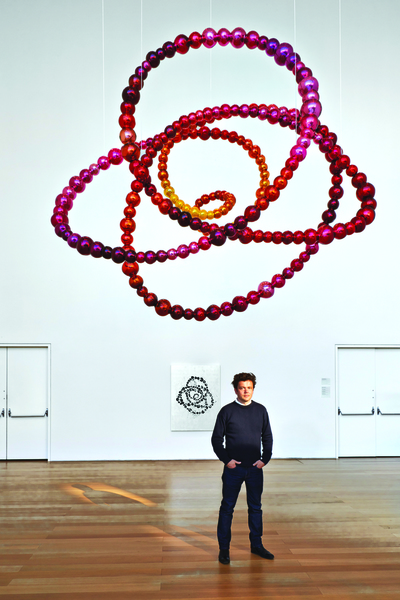Othoniel’s Beautiful Dance

Jean-Michel Othoniel, Peony, The Knot of Shame, 2015, mirrored glass, stainless steel, 118 1/8 x 118 1/8 x 78 3/4″. Photo: Charles Mayer.
Freshness, whimsy and playfulness are not often associated with the measured, august Versailles garden created by André Le Nôtre and commissioned by Louis XIV in 1661. However, in 2011, these ideas were paramount to landscape designer Louis Benech and sculptor Jean-Michel Othoniel as they began reinventing Versailles’ derelict Water Theatre Grove, a tree- and hedge-enclosed space designed for performances, particularly ballet. Opening in May, this is the first original new component to the garden in 350 years.
Le Nôtre’s Water Theater with its fountains, processional alleys, sculptures, stage area and stepped lawns for seating was a favorite of the king. After his death, it was neglected, simplified and then closed following destructive storms in the 1990s. In reimagining the sculpture and fountains in Le Nôtre’s design, Benech established a central pool featuring one of Othoniel’s jubilant sculptures, Les Belles Danses, which honors Louis XIV’s devotion to ballet with a series of large golden glass orbs arrayed in arabesques and spraying arcs of sparkling water. The work is based on actual dances choreographed by Louis XIV and recorded in an early book of dance notation, The Art of Describing Dance, by Raoul-Auger Feuillet, prepared under the king’s direction to aid dissemination of his ballets. As recreated by Othoniel, the steps-as-orbs capture the movement, joyfulness and grace of the king’s dances, and fix in glass and water play the evanescence of timing.
Othoniel crystallized this work in summer 2011 while living as an artist-in-residence at the Isabella Stewart Gardner Museum, an opportunity that gave him access to the Boston Public Library’s copy of Feuillet’s very rare book. Othoniel works with glassmakers in Murano and elsewhere who create the basic elements of his signature work: luminous colored glass orbs with mirrored interiors that reflect our world, while creating and sheltering another—reachable, yet unreachable. Taking various fantastic shapes—delicate, ironic, poised, leaping—their essence is a joy in form, light and color. They assert a bold claim on space, while acknowledging the ephemerality of these impressions, the fragility of their nature and, by extension, the mutability of the world of matter.
Othoniel’s work now can be seen at the Gardner in the site-specific installation Secret Flower Sculptures—four evocative gold-ground paintings and two assertively large sculptures: the outdoor La Rose des Vents, a rose sketched in gold-leafed aluminum spheres, designed to turn with the wind; and Peony, The Knot of Shame, rendered on an equally grand scale in mirrored rose and gold glass globes and hung in austere grandeur in the Hostetter Gallery. The concept for these works, too, originated during Othoniel’s Gardner residency. Charmed by the museum’s collections, Othoniel avidly explored in particular its many depictions of flowers: in carvings, paintings and metalwork; on tapestries, lacquerware and pottery; and, of course, in the Courtyard garden. One outcome of this fascination was the small volume The Secret Language of Flowers: Notes on the Hidden Meanings of Flowers in Art, unfolding the often surprising and contradictory symbolism and cultural associations of the leaves, fruits and flowers he found, leading to the current exhibit’s sculptures. The golden Rose des Vents evokes the rose’s associations with purity and regeneration, but also with the traditional wind-rose on mariner’s charts indicating the principal winds, while also giving a nod to one source of Gardner’s wealth. The peony—glorified in Asia, used as medicine in medieval Europe and regarded as a symbol of shame by Victorians—lends a darker edge to Othoniel’s conception. The peony’s unending, blushing tangle of color suspended overhead, shines like a cathedral rose window, though its beauty conceals the violence of its making and the transience of its being.
For those who may not be traveling to Paris soon, a scale model of Les Belles Danses, in shimmering golden glass, invites viewers to contemplate a glorious past while offering a joyful and yet fleeting embrace of the present.
Susan Boulanger, an editor and writer, lives in Cambridge, MA, with her family.
